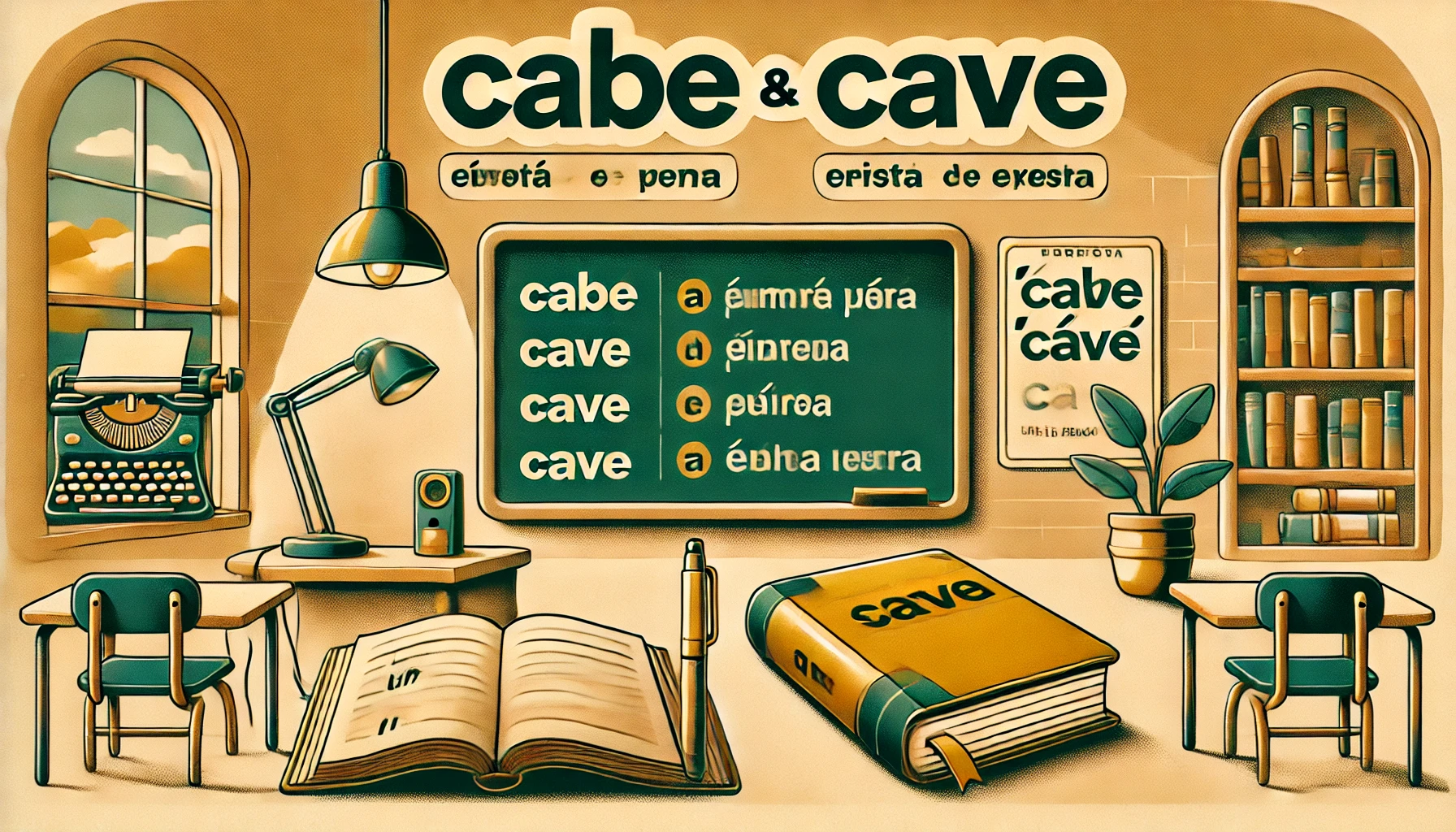Introduction
Learning a language like Spanish can be a fun adventure, but sometimes, similar words can cause confusion. Two such words are “cabe” and “cave.” These words sound alike, but they have different meanings and uses. Knowing when to use “cabe” and “cave” correctly can make your Spanish sound much more natural and clear.
This blog is inspired by a great article on https://tanfacil.net/educacion/como-se-escribe-cabe-o-cave-2821.html, which explains the difference between these two words. Let’s dive into the details to help you understand and use “cabe” and “cave” correctly in your writing.
Key Takeaways
a.Understand the Verbs:
“Cabe” is from “caber” (to fit), while “cave” is from “cavar” (to dig). Use “cabe” when discussing whether something fits into a space, and “cave” when talking about the action of digging.
b.Context Matters:
The context of your sentence will guide which word to use. “Cabe” is used for fitting, and “cave” is used for digging.
c.Avoid Mistakes:
To prevent mixing up these similar-sounding words, focus on the verb’s meaning and the sentence structure.
d.Practice and Resources:
Regular practice will help distinguish between “cabe” and “cave.” For additional guidance, refer to resources like https://tanfacil.net/educacion/como-se-escribe-cabe-o-cave-2821.html for more detailed explanations.
e.Effective Communication:
Correct usage of “cabe” and “cave” enhances clarity in Spanish communication and demonstrates a good grasp of the language.
What Does “Cabe” Mean?

In Spanish, “cabe” comes from the verb “caber.” The word “caber” means “to fit.” When you use “cabe,” you’re saying that something can fit into something else. It’s often used in sentences to show whether an object can be contained in a space.
Examples of “Cabe”:
- El libro cabe en la mochila.
(The book fits in the backpack.) - No sé si todo el equipaje cabe en el coche.
(I don’t know if all the luggage fits in the car.)
As you can see, “cabe” is used to talk about fitting things into places. It’s a simple and straightforward way to say if something can be contained.
What Does “Cave” Mean?
On the other hand, “cave” comes from the verb “cavar,” which means “to dig.” “Cave” is used when you need to talk about digging, like making a hole in the ground. This word is usually found in commands or suggestions, where someone is being asked to dig.
Examples of “Cave”:
- Es importante que él cave con cuidado para no dañar las tuberías.
(It is important that he digs carefully to avoid damaging the pipes.) - Cave un hoyo aquí para plantar el árbol.
(Dig a hole here to plant the tree.)
So, if you’re talking about digging, “cave” is the word you need.
Context Matters
The most important thing to remember when deciding between “cabe” and “cave” is the context. Context is like the clue that tells you which word is right. If you are talking about whether something fits, use “cabe.” If you are talking about digging, then “cave” is the correct choice.
Common Mistakes and How to Avoid Them
It’s easy to mix up “cabe” and “cave” because they sound so similar. But, with practice, you can learn to tell them apart. Here are a few tips to help you avoid mistakes:
Think About the Verb:
Before you choose a word, think about the action. If the action is fitting something into a space, use “cabe.” If the action is digging, use “cave.”
Check the Sentence Structure:
Look at the sentence. If it’s about something that happens now (present tense), “cabe” might be the word. If it’s a command or a suggestion, then “cave” could be the right choice.
Practice Makes Perfect:
The more you use these words, the better you’ll get at choosing the right one. Try writing your own sentences using both “cabe” and “cave” to get a feel for how they work.
Why Correct Usage Is Important
Using “cabe” and “cave” correctly is not just about avoiding mistakes. It’s about making sure your Spanish is clear and easy to understand. If you mix these words up, people might get confused about what you mean. But when you use them correctly, your communication becomes smoother and more professional, especially in writing.
A Quick Summary
Here’s a quick summary to help you remember:
| “Cabe” | is used when talking about fitting something into a space. It comes from the verb “caber.” |
| “Cave” | is used when talking about digging. It comes from the verb “cavar.” |
Practice with Real-Life Examples
Now that you know the difference, it’s time to practice. Here are some exercises to help you:
- Write a sentence where you talk about fitting something into a box. Use “cabe.”
- Write a sentence where someone is digging a hole in the garden. Use “cave.”
Why Ihttps://tanfacil.net/educacion/como-se-escribe-cabe-o-cave-2821.html is a Great Resource

If you want to learn more about these words, I recommend visiting Ihttps://tanfacil.net/educacion/como-se-escribe-cabe-o-cave-2821.html. This website offers a detailed explanation and more examples to help you understand the difference between “cabe” and “cave.” It’s a useful resource for anyone who wants to improve their Spanish.
Conclusion
Understanding the difference between “cabe” and “cave” is a small but important part of mastering Spanish. By knowing when to use each word, you can avoid common mistakes and make your Spanish clearer and more effective.
Remember, practice is key. The more you use these words, the easier it will be to choose the right one. And don’t forget to check out https://tanfacil.net/educacion/como-se-escribe-cabe-o-cave-2821.html for more tips and examples. Happy learning!
FAQS
1. What is the difference between “cabe” and “cave” in Spanish?
Answer: “Cabe” comes from the verb “caber,” which means “to fit.” It is used to describe whether something can fit into a space. For example, “El libro cabe en la mochila” means “The book fits in the backpack.” On the other hand, “cave” comes from the verb “cavar,” which means “to dig.” It is used when referring to the action of digging, as in “Cave un hoyo aquí para plantar el árbol” (Dig a hole here to plant the tree).
2. When should I use “cabe”?
Answer: Use “cabe” when you are talking about whether something can fit or be contained within something else. It is used in the third person singular form of the present tense. For example, “¿Cabe este cuadro en la pared?” means “Will this picture fit on the wall?”
3. When should I use “cave”?
Answer: Use “cave” when you are referring to the action of digging. It is used in the third person singular form of the present subjunctive or as an imperative command. For instance, “Es importante que él cave un agujero” means “It is important that he digs a hole.”
4. How can I avoid confusing “cabe” and “cave”?
Answer: To avoid confusion, remember the verbs they come from: “cabe” comes from “caber” (to fit), and “cave” comes from “cavar” (to dig). Check the context of your sentence—if it involves fitting something, use “cabe”; if it involves digging, use “cave.”
5. Are there any online resources to help with understanding “cabe” and “cave”?
Answer: Yes, a helpful resource is available at https://tanfacil.net/educacion/como-se-escribe-cabe-o-cave-2821.html. This site provides detailed explanations and examples to help clarify the correct usage of “cabe” and “cave” in Spanish.
